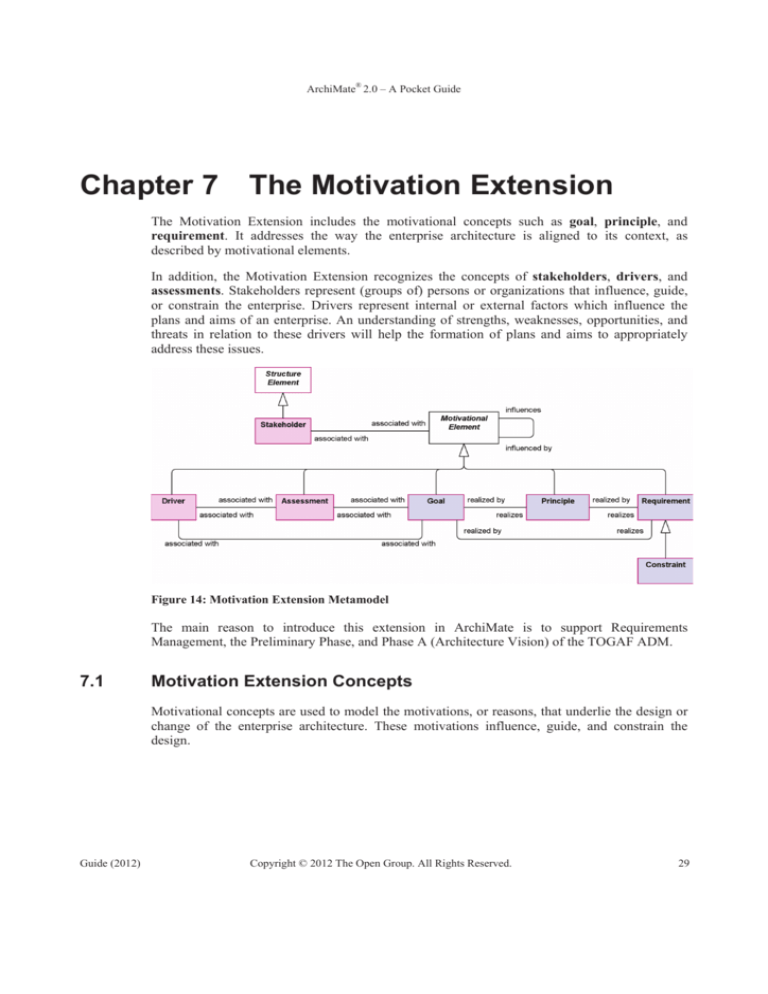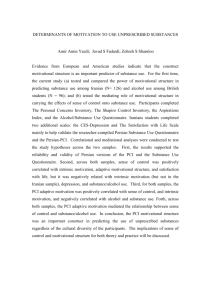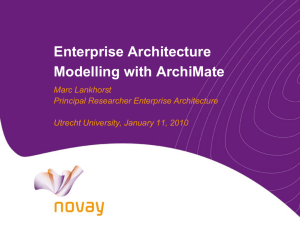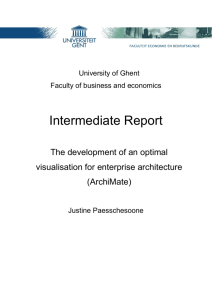
ArchiMate® 2.0 – A Pocket Guide
Chapter 7
The Motivation Extension
The Motivation Extension includes the motivational concepts such as goal, principle, and
requirement. It addresses the way the enterprise architecture is aligned to its context, as
described by motivational elements.
In addition, the Motivation Extension recognizes the concepts of stakeholders, drivers, and
assessments. Stakeholders represent (groups of) persons or organizations that influence, guide,
or constrain the enterprise. Drivers represent internal or external factors which influence the
plans and aims of an enterprise. An understanding of strengths, weaknesses, opportunities, and
threats in relation to these drivers will help the formation of plans and aims to appropriately
address these issues.
Figure 14: Motivation Extension Metamodel
The main reason to introduce this extension in ArchiMate is to support Requirements
Management, the Preliminary Phase, and Phase A (Architecture Vision) of the TOGAF ADM.
7.1
Motivation Extension Concepts
Motivational concepts are used to model the motivations, or reasons, that underlie the design or
change of the enterprise architecture. These motivations influence, guide, and constrain the
design.
Guide (2012)
Copyright © 2012 The Open Group. All Rights Reserved.
29
ArchiMate® 2.0 – A Pocket Guide
Table 12: Motivational Concepts
Guide (2012)
Concept
Definition
Stakeholder
The role of an individual, team, or
organization (or classes thereof) that
represents their interests in, or concerns
relative to, the outcome of the architecture.
In order to direct efforts to these interests
and concerns, stakeholders change, set,
and emphasize goals. The name of a
stakeholder should be a noun.
Driver
Something that creates, motivates, and
fuels the change in an organization.
Drivers may be internal, in which case
they are associated with a stakeholder.
Drivers may also be external; for example,
changing legislation. The name of a driver
should be a noun.
Assessment
The outcome of an analysis activity for a
driver or set of related drivers.
An assessment may reveal strengths,
weaknesses, opportunities, or threats for
some area of interest. The name of an
assessment should be a noun or a short
sentence.
Goal
An end state that a stakeholder intends to
achieve.
Goals are generally expressed using
qualitative words; for example, “increase”,
“improve”, or “easier”. Goals can also be
decomposed; for example, “increase
profit” can be decomposed into the goals
“reduce cost” and “increase sales”.
Requirement
A statement of need that must be realized
by a system.
Requirements represent the means to
realize goals. The name of a requirement
should be a short sentence.
Constraint
A restriction on the way in which a system
is realized.
This may be a restriction on the
implementation of the system (for
example, specific technology that is to be
used), or a restriction on the
implementation process (for example, time
or budget constraints). The name of a
constraint should be a short sentence.
Notation
Copyright © 2012 The Open Group. All Rights Reserved.
30
ArchiMate® 2.0 – A Pocket Guide
7.2
Concept
Definition
Principle
A normative property of all systems in a
given context, or the way in which they are
realized.
Principles are strongly related to goals and
requirements. A principle defines a general
property that applies to any system in a
certain context. The name of a principle
should be a short sentence.
Notation
Motivation Extension Relationships
The different types of relationships that can be used between two motivational elements and
between one motivational element and one core element are show in Table 13.
Table 13: Motivation Extension Relationships
Intentional Relationships
Guide (2012)
Aggregation
Aggregation models that some intentional
element is divided into multiple intentional
elements.
Realization
Realization models that some end is
realized by some means.
It is used to represent the following meansend relationships:
A goal (the end) is realized by a principle,
constraint, or requirement (the means).
A principle (the end) is realized by a
constraint or requirement (the means).
A requirement (the end) is realized by a
system (the means), which can be
represented by an active structure element,
a behavior element, or a passive structure
element.
Influence
Influence models that some motivational
element has a positive or negative
influence on the realization of another
motivational element.
A positive influence relationship does not
imply that the realization of the influenced
motivational element depends on the
contributing intention.
A negative influence relationship does not
imply that the realization of the influenced
motivational element is completely
excluded by the contributing motivational
element.
Notation
Copyright © 2012 The Open Group. All Rights Reserved.
31
ArchiMate® 2.0 – A Pocket Guide
As shown in Figure 15, a requirement or constraint can be related directly to a core element by
means of a realization relationship. Other motivational elements cannot be related directly to
core elements, but only indirectly by means of derived relationships via requirements or
constraints.
Figure 15: Relationships between Motivation Extension and the ArchiMate Core Concepts
Guide (2012)
Copyright © 2012 The Open Group. All Rights Reserved.
32






